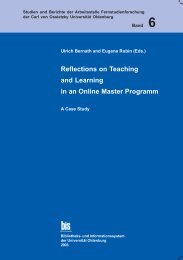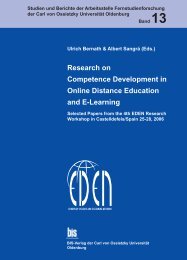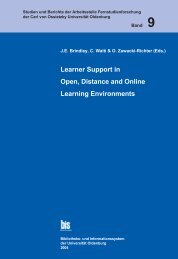Distance Education in Transition - Master of Distance Education ...
Distance Education in Transition - Master of Distance Education ...
Distance Education in Transition - Master of Distance Education ...
You also want an ePaper? Increase the reach of your titles
YUMPU automatically turns print PDFs into web optimized ePapers that Google loves.
The <strong>Education</strong>al Paradigm Shifts<br />
Pedagogical Shifts <strong>in</strong> Digitised Learn<strong>in</strong>g<br />
Really dramatic paradigm shifts will occur <strong>in</strong> the digitised learn<strong>in</strong>g environment. There<br />
the fundamental pattern <strong>of</strong> teach<strong>in</strong>g and learn<strong>in</strong>g <strong>in</strong> distance education will become a<br />
different one, an entirely different one. This shift will reduce the dom<strong>in</strong>ance <strong>of</strong> expository<br />
teach<strong>in</strong>g, a tradition which is several thousand years old. It will also open a perspective,<br />
which is new, entirely new, and so new, that we still do not yet know what it is all about<br />
and where it will lead. The reasons for this shift are, <strong>of</strong> course, as has been mentioned<br />
several times already, the technological advances <strong>in</strong> comput<strong>in</strong>g and network<strong>in</strong>g. They<br />
enable students, <strong>in</strong> pr<strong>in</strong>ciple, to have access to all the <strong>in</strong>formation <strong>in</strong> the world, to all<br />
teach<strong>in</strong>g programmes, to electronic books and to electronic libraries and <strong>in</strong>telligent expert<br />
systems. They have to study and learn <strong>in</strong> a situation and under circumstances, which are<br />
fundamentally different. This is not simply an addition <strong>of</strong> new technical media to the<br />
well-known traditional pedagogical structure, as was the case <strong>in</strong> its audio-visual era <strong>in</strong><br />
the sixties and seventies, when the pedagogical structure was changed only temporarily<br />
and <strong>in</strong> a superficial way. Rather, it represents such an impact on teachers and students<br />
that they have to redesign teach<strong>in</strong>g and learn<strong>in</strong>g. If we become aware <strong>of</strong> the unexpected<br />
consequences <strong>of</strong> the changes ahead <strong>of</strong> us we will be shocked. This phenomenon can be<br />
illustrated by deal<strong>in</strong>g with some aspects <strong>of</strong> these particular pedagogical shifts.<br />
Example 1: The New Approach<br />
So far it has been natural for us that teachers design "courses", a word which literally<br />
means ways, routes, tracks, roads with a beg<strong>in</strong>n<strong>in</strong>g and an end as well as with regular<br />
stops at given <strong>in</strong>tervals. If teachers want to make the students to follow a particular<br />
"way" <strong>in</strong> which the contents are to be "transmitted" these contents have to be chosen<br />
and def<strong>in</strong>ed clearly and then they have to be articulated, which means that the contents<br />
<strong>of</strong> the course have to be portioned out, and to be subdivided <strong>in</strong>to workloads to be<br />
mastered at given times. In addition, the contents have to be presented to given persons,<br />
at given places, and at given times. Only <strong>in</strong> this way teachers could teach and students<br />
could learn. Hence, we have developed the notion that knowledge must always be<br />
transmitted by means <strong>of</strong> such articulated courses, whether it is a lecture, classroom<br />
<strong>in</strong>struction or distance education with prefabricated "course"-units. And this notion is<br />
embodied deeply <strong>in</strong> our consciousness.<br />
We are now confronted with another major irritat<strong>in</strong>g and disturb<strong>in</strong>g paradigm shift, this<br />
time a pedagogical one. In the digital learn<strong>in</strong>g environment many <strong>of</strong> these important and<br />
necessary prerequisites <strong>of</strong> traditional teach<strong>in</strong>g and learn<strong>in</strong>g are obsolete and irrelevant.<br />
Students are now able to get hold <strong>of</strong> any <strong>in</strong>formation they need without the traditional<br />
preparation, assistance and expository acts <strong>of</strong> a teacher and outside predeterm<strong>in</strong>ed<br />
places and times. This shift means that teach<strong>in</strong>g and learn<strong>in</strong>g is quite a different process<br />
<strong>in</strong> which teach<strong>in</strong>g behaviour and learn<strong>in</strong>g behaviour have undergone a radical change.<br />
Students have to develop their abilities <strong>of</strong> self-<strong>in</strong>struction and <strong>of</strong> becom<strong>in</strong>g autonomous<br />
learners. They have to develop activities unknown before, for example: quick data<br />
retrieval, data management, choos<strong>in</strong>g among vast numbers <strong>of</strong> central sources, choos<strong>in</strong>g<br />
from multiple forms <strong>of</strong> representation, brows<strong>in</strong>g, navigat<strong>in</strong>g or follow<strong>in</strong>g a guided tour<br />
<strong>in</strong> hypertexts or collaborat<strong>in</strong>g with other students <strong>in</strong> a knowledge build<strong>in</strong>g community,<br />
learn<strong>in</strong>g by us<strong>in</strong>g models and simulations, meet<strong>in</strong>g other students on-l<strong>in</strong>e, <strong>in</strong> order to<br />
31





